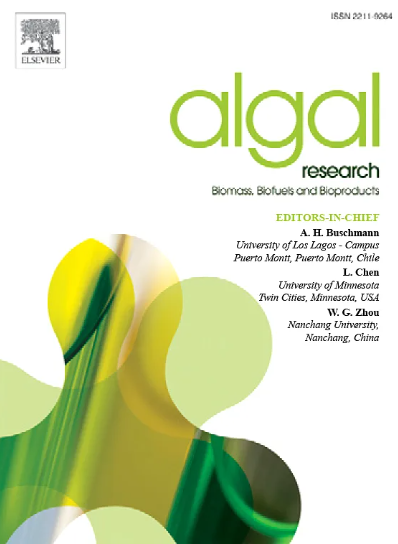24-Epibrassinolide 通过增强光合作用促进盾形藻的生长和有机化合物的积累
IF 4.6
2区 生物学
Q1 BIOTECHNOLOGY & APPLIED MICROBIOLOGY
Algal Research-Biomass Biofuels and Bioproducts
Pub Date : 2024-10-15
DOI:10.1016/j.algal.2024.103753
引用次数: 0
摘要
24-epibrassinolide (EBL)是第六类植物激素黄铜激素(BRs)中常用的一种,在植物生长发育过程中发挥着重要作用。盾叶藻(Dunaliella parva,D. parva)是一种重要的产脂微藻,其生长和有机化合物的积累需要进一步改善,以获得更高的应用价值。然而,目前还不清楚 EBL 对 D. parva 的影响。在本研究中,用不同浓度的 24-epibrassinolide (EBL) 处理 D. parva,以评估其影响。叶绿素、类胡萝卜素、碳水化合物、淀粉、蛋白质的含量分别为对照组的1.31倍、1.18倍、1.49倍、1.35倍和1.54倍。EBL 处理组 rbcS、rbcL、RuPE、PRK、TPI、FBPA、FBPase、SBPase、DpME、CA 的 mRNA 水平分别是对照组的 1.94-、2.43-、2.14-、1.76-、1.97-、2.21-、1.48-、1.96-、2.06- 和 1.89 倍。EBL处理组的ME、CA和RuBisCO酶活性最高,分别为对照组的1.27倍、1.23倍和1.37倍。0.4 mg/L EBL 处理组的脂质含量是对照组的 1.44 倍。这项研究证明了 EBL 在获得更高的生物量和有机化合物积累方面的巨大潜力。我们的研究表明,EBL 处理对随后以微藻生物质为原料进行生物燃料和其他高价值代谢物的商业化生产很有价值。本文章由计算机程序翻译,如有差异,请以英文原文为准。
24-Epibrassinolide promoted growth and organic compounds accumulation in Dunaliella parva by enhancing photosynthesis
As a commonly used type of the sixth class of phytohormones brassinosteroids (BRs), 24-epibrassinolide (EBL) plays the important roles in plant growth and development. Dunaliella parva (D. parva) is an important lipid-producing microalga, and its growth and accumulation of organic compounds need to be further improved for higher application value. However, the effects of EBL on D. parva are still unclear now. In this study, D. parva was treated with different concentrations of 24-epibrassinolide (EBL) to evaluate its influence. Cell density of 0.5 mg/L EBL treated group was 1.28-fold of control at 18 d. The contents of chlorophyll, carotenoid, carbohydrate, starch, protein of 0.5 mg/L EBL treated group were 1.31-, 1.18-, 1.49-, 1.35-, and 1.54-fold of control. The highest mRNA levels of rbcS, rbcL, RuPE, PRK, TPI, FBPA, FBPase, SBPase, DpME, CA in EBL treated group were 1.94-, 2.43-, 2.14-, 1.76-, 1.97-, 2.21-, 1.48-, 1.96-, 2.06-, and 1.89-fold of control. The highest enzymatic activities of ME, CA and RuBisCO in EBL-treated group were 1.27-, 1.23-, and 1.37-fold of control. Lipid content of 0.4 mg/L EBL treated group was 1.44-fold of control. This study demonstrated the great potential of EBL to obtain higher biomass and organic compounds accumulation. Our study indicates that EBL treatment is valuable for the subsequent commercial production of biofuel and other high-value metabolites using microalgal biomass as raw material.
求助全文
通过发布文献求助,成功后即可免费获取论文全文。
去求助
来源期刊

Algal Research-Biomass Biofuels and Bioproducts
BIOTECHNOLOGY & APPLIED MICROBIOLOGY-
CiteScore
9.40
自引率
7.80%
发文量
332
期刊介绍:
Algal Research is an international phycology journal covering all areas of emerging technologies in algae biology, biomass production, cultivation, harvesting, extraction, bioproducts, biorefinery, engineering, and econometrics. Algae is defined to include cyanobacteria, microalgae, and protists and symbionts of interest in biotechnology. The journal publishes original research and reviews for the following scope: algal biology, including but not exclusive to: phylogeny, biodiversity, molecular traits, metabolic regulation, and genetic engineering, algal cultivation, e.g. phototrophic systems, heterotrophic systems, and mixotrophic systems, algal harvesting and extraction systems, biotechnology to convert algal biomass and components into biofuels and bioproducts, e.g., nutraceuticals, pharmaceuticals, animal feed, plastics, etc. algal products and their economic assessment
 求助内容:
求助内容: 应助结果提醒方式:
应助结果提醒方式:


